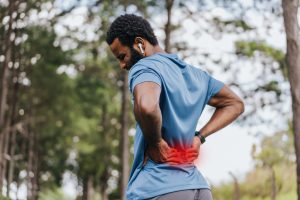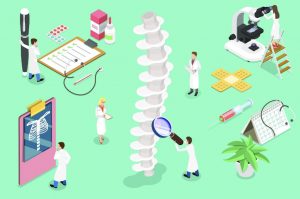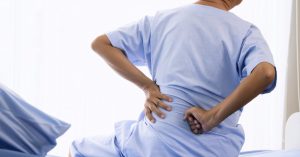Spinal Narrowing
Spinal narrowing, also known as spinal stenosis, is a very broad term that describes constriction of the already tight nerve pathways in the spinal column. In addition to helping our upper body stay upright, the spine is responsible for protecting the spinal cord as it travels from the brain to the rest of the body. The spinal cord is protected by the central spinal canal and individual nerve roots exit through small openings called foramina.
Spinal narrowing occurs when displaced spinal anatomy, such as a bulging or herniated disc or a bone spur, constricts either the central spinal canal or the foramina. This is a surprisingly common condition and it’s even possible for patients to develop this condition without knowing. However, if spinal narrowing results in compression of the spinal cord or nerves in and around the spinal column, debilitating symptoms can occur.
Causes
Spinal narrowing can occur for a variety of reasons. Whether you have recently been diagnosed with spinal narrowing or you’re researching potential causes of neck pain, back pain, or other symptoms, learning about the risk factors for this condition can help. From both a treatment and prevention standpoint, understanding spinal narrowing risk factors can help you adopt a more spine-friendly lifestyle that can help you on a long-term basis.
The following are different causes as to why an individual might experience spinal narrowing:
- Age-related degeneration: The primary cause of spinal narrowing is simply the natural aging process. As we get older, our bodies tend to dry out and lose elasticity. The spinal column is highly flexible, it requires rubbery spinal discs and the spinal facet joints to bend and flex smoothly.
- Injury: Although the injury is less of a direct risk factor for spinal narrowing than many people think, it can still be a significant contributor. Traumatic injuries such as falls or motor vehicle accidents can cause injuries to the discs or vertebrae that narrow the spinal column and causes compression of the spinal cord or nerves.
- Being overweight or obese: Carrying extra body weight, especially for long periods of time, is a major risk factor for spinal narrowing. This is because the extra weight increases the stress on spinal anatomy and can compound natural degenerative forces.
- A sedentary lifestyle: Being inactive is associated with being a spinal narrowing risk factor for a number of reasons. First, it is associated with muscle atrophy, including the muscles that support the spinal column. These muscles help reduce pressure on the spinal column and keep the space as open as possible for the spinal cord or nerves.
- Posture and mechanics: The way we hold and move our bodies every day can have a marginal, yet significant, impact on the health of our spinal column. Poor posture can result in uneven pressure on the spinal anatomy that can be associated with faster degradation over time.
Conservative Treatments
Effective treatment for spinal narrowing depends on identifying the source of the problem and relieving the nerve compression in the spine. For immediate pain relief, there are some ways to help control your symptoms at home. Some options include:
- Getting rest to take pressure off the spine
- Over-the-counter medication, such as nonsteroidal anti-inflammatory drugs
- Physical therapy to improve range of motion and strengthen supporting muscles
- Hot and or cold compression therapy
- Anti-inflammatory corticosteroid injections
Symptoms
Spinal narrowing can lead to a variety of symptoms. Some of the most common symptoms experienced by patients with spinal narrowing include:
- Numbness or tingling
- Weakness in the hand, arm, foot, or leg
- Difficulty walking
- Neck pain
- Balance dysfunction
If you are experiencing any severe symptoms, you should consult with your doctor to prevent the pain from worsening.
Diagnosis
The diagnostic process will typically begin with your primary care physician. They will review your symptoms and ask questions regarding your previous medical history. After a physical examination, your doctor will likely request one of the following imaging tests:
- X-ray
- MRI
These tests allow the physician to take images of your spine which can reveal any abnormal qualities, including spinal narrowing. After the diagnostic process, the professional will go over your condition and assess your treatment options.
Surgical Options
If a patient has fully exhausted these methods and is still experiencing symptoms, there are surgical options available to help. The goal of spinal stenosis surgery is to access the spine and relieve nerve compression by removing displaced or damaged spinal anatomy that is the source of narrowing.
Many patients look to avoid spine surgery due to its highly-invasive nature, but BEST Health System offers minimally invasive options. By using a small incision and muscle-sparing techniques, the highly skilled surgeons at BEST can access the source of spinal stenosis with far less disruption of soft tissue. The result is an outpatient procedure that helps patients get back on their feet and on the road to recovery.
Reach out to BEST Health System
If you are experiencing back pain, don’t suffer in silence. The highly skilled medical professionals at BEST Health System are dedicated to finding you the most effective, least invasive treatment option.
Related Articles
The New Way Patients Are Finding Relief from Chronic Back Pain
Living with Chronic Back Pain Living with chronic back pain can be incredibly challenging, and can impact your life in countless ways. Chronic back pain, […]
The Anatomy of a Spinal Cord Stimulator
What is a Spinal Cord Stimulator? A spinal cord stimulator is a surgically implanted modern medical device that offers relief to patients who experience severe […]
Common Spinal Narrowing Symptoms
Living with Spinal Narrowing The symptoms of spinal narrowing vary depending on the location of the condition. For some, spinal narrowing causes neck pain. For […]
Can a Sports Injury Cause Canal Stenosis?
Sports Injuries Causing Spine Conditions Participation in sports is a leading cause of spinal canal stenosis among athletes and younger individuals. Those who participate in […]
Spinal Narrowing Symptoms
Spinal Narrowing Symptoms The symptoms of spinal narrowing vary depending on the location of the condition. For some, this condition causes neck pain. For others, […]
Spinal Narrowing - Conservative Treatments
Have You Been Diagnosed with Spinal Narrowing? For patients with mild to moderate spinal narrowing, treatment options can include medications, exercise, and alternative therapies. However, […]
What Causes Spinal Stenosis?
What is Spinal Stenosis? The narrowing of the spinal canal, also known as spinal stenosis, is one of the most common spine conditions. The central […]
Spinal Narrowing - An Overview
What is Spiral Narrowing Spinal narrowing, also known as spinal stenosis, can occur due to a variety of factors. This includes injury to the spine, […]
Spinal Narrowing – Seven Reasons Why It's More Common Than You Think | BEST
Spinal narrowing, or spinal stenosis, is a term that describes the loss of space in the spinal column. In particular, spinal narrowing often results in […]
Seven Spinal Narrowing Risk Factors You Should Know
Spinal narrowing, or spinal stenosis, is a broad term describing constriction of pathways in the spine. Along with helping our upper body stay upright, the […]








